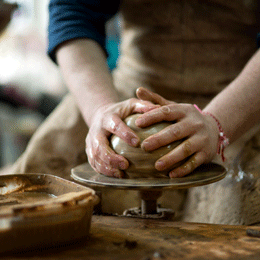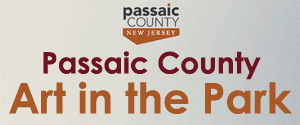
“It’s so inviting and once people start, they really can’t stop and that’s a big part of it,” says Say It With Clay Founder Abbie Kasoff.
Kasoff began working with clay in ninth grade and never stopped. She went to art school and studied clay and then continued to work with it through some of her adult life. Once she got her studio space, which was originally a different type of company, she eventually turned it into Say It With Clay, and Kasoff was able to get back into clay and help others in the process.
Say It With Clay is a nonprofit organization in Collingswood dedicated to helping adults and children with disabilities benefit from the therapeutic opportunities that clay provides. The organization offers two different programming routes for its clients.
“On our general programming, people get to make pretty much whatever they want,” Kasoff says. This ranges from traditional pottery classes to drawing, hand building pottery, jewelry making and more. Say It With Clay even offers a “Stress Reduction Workshop,” which is open to all and aimed to relax and alleviate stress.
“Then we have our therapeutic programming which is individualized therapy programming, groups, parent and child relationship building, addiction, seniors with Alzheimer’s and [more],” Kasoff says.
“We can offer healing from any kind of emotional trauma. We can offer healing from medical illnesses and/or physical illnesses. Basically, the populations we serve are anybody with physical, medical, mental, emotional and behavioral disabilities. We work with kids with autism, we work with kids with Down syndrome, we work with developmentally disabled adults, we work with adults with Alzheimer’s [and] we work with cancer survivors.”
Kasoff’s team will even travel out during their therapeutic programming. They go to hospitals, rehab facilities, afterschool programs, Alzheimer’s associations, occupational training centers—the list goes on.
“Our travel program is great because there aren’t a lot of people who travel out and do what we do with clay specifically,” Kasoff says. “So we bring bags of clay and rolling pins and everything with us.”
Say It With Clay’s success is obvious. Kasoff says she has quite a few customers from her general programming who have been coming back for years in her drawing classes and hand-building classes. She even has children who come back every summer for their summer camp.
And when it comes to their therapeutic programming, Kasoff says timing is everything.
“I just started working with a young lady and her mother on an individual basis and they were just telling me yesterday that they did their six weeks and now they can’t wait to renew and they are going to continue,” Kasoff says. “The mother is so happy because this is the first time the daughter has never been resistant about going through a therapy program and it’s really working. Even her dad said he could tell his daughter seems less stressed out.”
One might think, ‘How can clay really help a person and be a form of therapy?’ It can help on a few different levels, Kasoff explains. Physically, it can help people who need occupational therapy. Emotionally, it helps people who have trouble verbally sharing information.
“So, clay specifically, it’s buildable, it gives people the opportunity to build things in the three-dimensional form which other types of art therapy do not,” she says. “They are great and I have a lot of fellow colleagues of mine who are amazing art therapists who own private practices, but with clay itself, you don’t have to have a specific skill to do [it].”
Kasoff also attributes the success of clay because it gives her clients the ability to have a finished product. It can be something that is functional that they can keep or give away, like a bowl or mug.
“Other forms of art don’t necessarily do that as much as clay does,” Kasoff says. “That was one of the reasons that I knew what we did was going to be successful and different because for parents of kids with special needs, or adults who are special needs or people who are handicapped, to make something that you can then use there is just a whole other level of giveback that it [has].”
For people who can’t afford to work with Say It With Clay for their therapeutic programming, Kasoff has created scholarship funds. The organization’s big fundraisers put 100 percent of their proceeds into their scholarship funds.
“Everybody has a right to treatment,” Kasoff says. “So whatever your treatment is, if art therapy with clay is what works for you, you should be able to utilize it.”
While it is still in its early stages, Say It With Clay has a scholarship review committee made up of two community partners, two clinical staff members and two board members. If someone is interested in the organization’s services, they fill out a small application form of why they think they would benefit from the program and the committee takes it from there. Then as a team they decide who should get what. It could be six weeks or four weeks or an afterschool program or something else.
She has also done in-home work through her scholarship funds for clients who couldn’t get to the studio.
“The bigger picture for me is that we should not have to say no to anybody if we don’t want to,” Kasoff says. “That’s really what I believe in my heart.”
Published (and copyrighted) in South Jersey Magazine, Volume 13, Issue 2 (May, 2016).
For more info on South Jersey Magazine, click here.
To subscribe to South Jersey Magazine, click here.
To advertise in South Jersey Magazine, click here.












